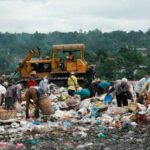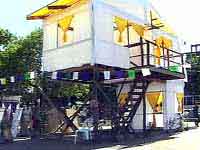Stories of Systemic Change (This marks the fourth in a series of 10 Vincentian family projects that will be described by Fr. Robert Maloney, Chair of the Systemic Change initiative in the Vincentian Family.)
 4. The Homeless People’s Federation of the Philippines
4. The Homeless People’s Federation of the Philippines
A saving program became the glue that held a community of homeless together. It was a stepping-stone for the “garbage dump dwellers” of Payatas, bringing about a tremendous systemic change that transformed their living situation permanently for the better.
![]() In the northern part of metro Manila is a city, hidden from the eyes of most visitors. It is called Quezon City, where Payatas is located, and it is one of the region’s major dumpsites. It was also, until recently, a place called home by over 50,000 people.
In the northern part of metro Manila is a city, hidden from the eyes of most visitors. It is called Quezon City, where Payatas is located, and it is one of the region’s major dumpsites. It was also, until recently, a place called home by over 50,000 people.
In this enormous trash dump, families with very young children scavenged through the trash to make their livelihood by selling their findings to junk shops or recycling centers. The people were very poor and, in addition to enduring the site’s overwhelming stench, they suffered from grave problems like malnutrition, lack of pure water, infant mortality, and lack of education for those who survived. To make matters worse, rainy seasons rendered the mountain of trash unstable and caused fatal trash-slides.
In 1991, Fr. Norberto Carcellar, C.M., was assigned to Payatas. After becoming acquainted with community-based savings initiatives in other countries, he began to believe that such a savings program in Payatas could be a unifying force for his people and help them improve their own situation.
 June of 1995 saw Fr. Carcellar and a few volunteers from Payatas beginning a community-based and -operated savings initiative. From those who wished to participate, he collected small savings of $1 a week or $0.50 a day. Gradually, the number of the savers increased, and a growing number of volunteers began to help Fr. Carcellar in his office. As they did this, they learned the basics of bookkeeping through hands-on experience.
June of 1995 saw Fr. Carcellar and a few volunteers from Payatas beginning a community-based and -operated savings initiative. From those who wished to participate, he collected small savings of $1 a week or $0.50 a day. Gradually, the number of the savers increased, and a growing number of volunteers began to help Fr. Carcellar in his office. As they did this, they learned the basics of bookkeeping through hands-on experience.
Word of the initiative spread as others were taught the rudiments of the new scheme. Within two and a half years, the savings program listed 5,300 depositors belonging to 540 savings groups. These included jeepney drivers, market vendors, tricycle drivers, school children, mothers saving for infants, and the elderly.
 The savers were soon able to make down payments on land purchases and, leaving the dumpsite, they became recognized by the Philippine government as landowners. In addition, the savings association offered small loans at market interest rates to members of the community. These loans enabled the poor to do such things as set up small shops, or begin small businesses. These initiatives, in turn, generated a steady income, from which they then paid back the loans and improved their quality of life.
The savers were soon able to make down payments on land purchases and, leaving the dumpsite, they became recognized by the Philippine government as landowners. In addition, the savings association offered small loans at market interest rates to members of the community. These loans enabled the poor to do such things as set up small shops, or begin small businesses. These initiatives, in turn, generated a steady income, from which they then paid back the loans and improved their quality of life.

The Homeless People’s Federation of the Philippines has become very broad in scope. Now, at the beginning of 2008, it plays a key role in promoting savings in Southeast Asia. The Philippine Federation is affiliated with an international network called Slum/Shack Dwellers International. Its leaders travel to East Timor, Banda Aceh, Indonesia and Mongolia to share their technical expertise in organizing communities through savings.
The emphasis from the start was on the community of savers. The savings program became the glue that held the community together. It was a stepping-stone for the people of Payatas, bringing about a tremendous systemic change that transformed their living situation permanently for the better.
See earlier famvin articles about Norberto Carcellar, CM
Payatas and Vincentian on YouTube
Tags: Featured, Homelessness

Father’s work was recognized with a $100.000 prize from the Opus Foundation. Another member of the Vincentian family won the 1 million dollar first prize.
http://www.opusprize.org/winners/winners.cfm